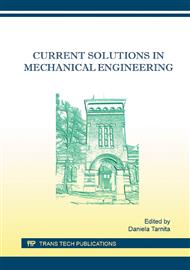[1]
G. Boyle, Renewable energy, OXFORD university press, (2004).
Google Scholar
[2]
H. Zhu, J. Wei, K. Wang y D. Wu, Applications of carbon materials in photovoltaic solar cells, Solar Energy Materials and Solar Cells, 93(9), (2009) 1461-1470.
DOI: 10.1016/j.solmat.2009.04.006
Google Scholar
[3]
R. Bube, Photoelectronic Properties of Semiconductors, Cambridge University, Cambridge (1992), particular note the discussion given in, (1992) 232-233.
Google Scholar
[4]
M. Engin y D. Engin, Optimization mechatronic sun tracking system controller's for improving performance, de Mechatronics and Automation (ICMA), 2013 IEEE International Conference, (2013).
DOI: 10.1109/icma.2013.6618069
Google Scholar
[5]
W. Batayneh, A. Owais y M. Nairoukh, An intelligent fuzzy based tracking controller for a dual-axis solar PV system, Automation in Construction, 29, (2013) 100-106.
DOI: 10.1016/j.autcon.2012.09.006
Google Scholar
[6]
A. N. Celik y N. Acikgoz, Modelling and experimental verification of the operating current of mono-crystalline photovoltaic modules using four-and five-parameter models, Applied energy, 84(1), 92007) 1-15.
DOI: 10.1016/j.apenergy.2006.04.007
Google Scholar
[7]
D. Sinha y E. R. Dougherty, Fuzzification of set inclusion: theory and applications, Fuzzy sets and systems, 55(1) (1993) 15-42.
DOI: 10.1016/0165-0114(93)90299-w
Google Scholar
[8]
L. -X. Wang, Adaptive fuzzy systems and control: design and stability analysis, Prentice-Hall, Inc., (1994).
Google Scholar
[9]
W. Z. Qiao y M. Mizumoto, PID type fuzzy controller and parameters adaptive method, Fuzzy sets and systems, 78(1), (1996) 23-35.
DOI: 10.1016/0165-0114(95)00115-8
Google Scholar
[10]
L. -X. Wang y J. M. Mendel, Generating fuzzy rules by learning from examples, Systems, Man and Cybernetics, IEEE Transactions on, 22(6), (1992) 1414-1427.
DOI: 10.1109/21.199466
Google Scholar
[11]
H. Hellendoorn y C. Thomas, Defuzzification in fuzzy controllers, Journal of Intelligent \& Fuzzy Systems: Applications in Engineering and Technology, 1(2), (1993) 109-123.
DOI: 10.3233/ifs-1993-1202
Google Scholar
[12]
K. J. Åström y B. Wittenmark, Adaptive control, Courier Corporation, (2013).
Google Scholar
[13]
I. Landau, A survey of model reference adaptive techniques—theory and applications, Automatica, 10(4), (1974) 353-379.
DOI: 10.1016/0005-1098(74)90064-8
Google Scholar
[14]
S. Sastry y M. Bodson, Adaptive control: stability, convergence and robustness, 1989, Prentice-Hall, Inc, (1989).
Google Scholar
[15]
F. R. Rubio y M. J. L. Sánchez, Control adaptativo y robusto, vol. 9, Universidad de Sevilla, (1996).
Google Scholar


